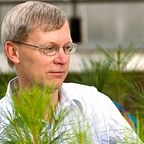# Forest Food Webs: Unraveling the Complex Connections
Forests, with their rich biodiversity, host intricate food webs that showcase the interdependence of various species within the ecosystem. Unlike a simple food chain, a food web illustrates the multitude of relationships among organisms, highlighting the complexity of nature. Let’s explore a forest food web, shedding light on the diverse interactions that sustain life in these lush environments.
## Primary Producers: Trees and Plants
At the base of the forest food web are the primary producers, mainly trees and plants. Through photosynthesis, they convert sunlight into energy, providing the foundation for the entire ecosystem.
- **Examples:** Oak trees, pine trees, ferns, and mosses.
## Primary Consumers: Herbivores
Herbivores are the primary consumers that directly feed on the vegetation produced by the primary producers. They play a crucial role in regulating plant populations.
- **Examples:** Deer, rabbits, insects, and birds.
## Secondary Consumers: Carnivores and Omnivores
Carnivores and omnivores are the secondary consumers that feed on herbivores. They contribute to the regulation of herbivore populations and further transfer energy through the food web.
- **Examples:** Foxes, snakes, owls, and bears.
## Tertiary Consumers: Top Predators
Top predators are at the apex of the forest food web. They maintain the balance of the ecosystem by controlling the populations of various species below them in the trophic levels.
- **Examples:** Wolves, cougars, eagles, and large cats.
## Decomposers: Nature’s Recyclers
Decomposers are instrumental in recycling nutrients. They break down organic matter, such as dead plants and animals, into simpler compounds, returning essential elements to the soil.
- **Examples:** Bacteria, fungi, and insects like beetles.
## Interconnected Relationships
### Mutualism
In a forest, mutualistic relationships are common, where two species benefit each other. An example is the mycorrhizal association between trees and fungi. Trees provide sugars to the fungi, and, in return, the fungi enhance the tree’s nutrient absorption capabilities.
### Parasitism
Parasitic relationships involve one organism benefiting at the expense of another. Some plants in the forest may be parasitic, extracting nutrients from host plants. Insects like ticks and lice are also examples of parasites in the forest ecosystem.
### Commensalism
Commensal relationships occur when one species benefits, and the other is neither harmed nor helped. An example is a bird building a nest in a tree. The bird benefits by having a place to live, while the tree is unaffected.
## The Impact of Human Activities
Human activities, such as deforestation, logging, and pollution, can disrupt forest food webs. The removal of certain plant species or the introduction of invasive species can have cascading effects on the entire ecosystem. Conservation efforts are crucial to maintaining the delicate balance of these intricate food webs.
## Conclusion
Forest food webs are dynamic and intricate, showcasing the interdependence of organisms within ecosystems. Understanding these connections is essential for conservation efforts and promoting the health and sustainability of forests. As stewards of the environment, it is our responsibility to appreciate and protect the diverse and interconnected web of life that thrives in these lush and vital ecosystems.
